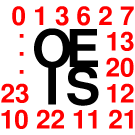On the previous blog I installed the free-as-in-beer version of the ClustrMaps gadget. They recently enhanced the quality of the data provided to the users of the free version of the product. Before, the “Current Country Totals” table listed the countries from which the site had been visited, and the number of hits for each country. Now, each countries count is expandable, and tallied by state or province for the United States and Canada, and city for the rest of the countries. The table itself (and the red dots on the map) still only reflect visits prior to the most recent update. One doesn’t get an update unless/until the total hit count is 5% (if I’m not mistaken) above what it was at the previous update, until it tops 1,000, and then it’s 10%. Another added feature is that the ten most recent hits are listed by city/state/province and country just below the map, and represented by yellow dots on the map. I suppose at this point someone could do an end run around the update policy by writing a screen scraper to look at the “yellow dot” entries at periodic intervals. Of course universities, who have a long tradition of operating their own physical servers, routinely dump far higher resolution server stats directly into the public domain. Ownership has its privileges, as they say—as does “server side netizenship.”
At first glance, this appears to be an example of free enterprise, or making an enterprise of what used to be free. During the mid-1990’s migration of the Internet from the .edu domains to the .com domains, finger and talk were replaced by instant messaging, IRC was replaced by chat rooms, USENET by message boards, blogs and eventually social network-type websites. All the relevant technology was in place before the commercialization of the Internet. Apparently what was needed to take it to the next level was the necessity of hanging a business model on it. So today, I still check my email, still check what people are posting online, still live chat once in a blue moon, only now I’m using 200 times as much bandwidth, 3,000 times as much memory and 400 times the clock speed.

Leave a Reply